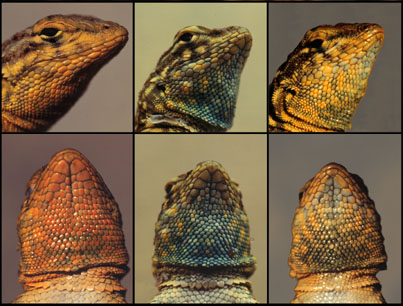We're open daily! View holiday hours
Science News
Leaping Lizards
February 23, 2010

Lizards morph into new species.
How do new species develop? Well, in many cases, it takes the geographic separation of a population to get that process started. However, researchers out of UC Santa Cruz studying colorful and charismatic lizards have been working to confirm an alternative hypothesis that's existed since Darwin that a population containing different morphs-- different types of the same species can, over time, yield new species.
Scientists in Barry Sinervo's Lab have been studying the side-blotched lizard for over 20 years. Within this species there are three distinct color morphs-- orange-throated, blue-throated and yellow-throated lizards.
A few years ago, Dr. Sinervo and his team discovered that competition among male side-blotched lizards for territory and mates takes the form of a rock-paper-scissors game, where the aggressive orange-throated lizard can take the territory from a blue-throated; the blue-throated can work in teams to defend against the yellow-throated; and the non-territory holding yellow-throated can mimic females in order to sneak onto the territory of an orange-throated and mate with females there.
Side-blotched lizards live in the western and southwestern United States and into Mexico. In some areas, all three morphs live side-by-side, but in others, one or two of the morphs are missing. As published recently in the Proceedings of the National Academy of Sciences, it's in these areas that two things are happening which may be leading to the evolution of new species.
One: There are populations where one or two of the morphs have been lost, leaving just a single-colored morph. As that morph takes over, adaptations that were beneficial before become unnecessary, leading to evolutionary change and new adaptations emerging.
Two: Evidence of this evolutionary change is supported by the fact that a new subspecies of side-blotched lizards have been identified in populations where one or two of the three morphs have been lost. This is significant since subspecies are the precursors to new species.
DNA testing supports the idea that cycling between color morphs has been happening within some populations of side-blotched lizards for many millions of years. The research here suggests that, in some cases, this cycling may eventually result in the loss of one or two morphs which, in turn, could lead to the evolution of new species. But that probably won't happen until further down the road. Remember, evolution can be a very slow process.
Image from LizardLand!